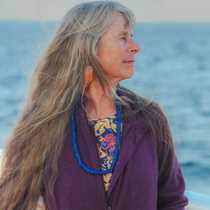Bahia Magdalena
Gray skies greeted the Sea Lion as she lay at anchor inside Bahia Magdalena. In the soft light the world of this barrier island environment exploded with color! The muted light browns of the sand dunes against the many shades of green in the Mangroves were in perfect balance. Our morning activities would be, either kayaking or Zodiac tours in this unique Mangrove ecosystem. High tide would beat 10:00 AM giving us the maximum opportunity for excellent passage through the many secret channels that make up a Mangrove estuary.
Soon, Zodiacs were launched and we assembled at the aft section of the Sea Lion in preparation for our first Zodiac tour. Once loaded each small vessel made its way across a small bay and into the tight network of tidal channels of the Mangrove community. Immediately, the naturalists began their enthusiastic discussions of this unique grouping of plants, birds and animals. Many a boat pulled in close to each different Mangrove; Red, White and Black -- soon we heard of each specific characteristic making these plants independently unique! The Red mangrove with an unusual reverse osmosis system for the prevention of salt entering the plant. This particular plant was in full bloom. Tiny little yellow flowers covered almost all the Red mangrove shrubs we passed. The White mangrove was covered with new foliage, due to recent rains that have blessed the Baja peninsula this last year. The Black mangrove was also in bloom. Tiny white flowers clustered at the ends of branches, responding to rain, sun and spring in Baja!
Inside the thick Mangrove shrubs we soon discovered the sounds of many birds. Each Zodiac driver moved into his or her secret channel, turned off the engine and enjoyed the varied bird sounds. Mangrove warblers sang from deep in the foliage, fluttering up swiftly, giving only the most observant guest a glimpse! As the Zodiacs continued we soon spotted a group of birds deeply camouflaged by tiny shore plants. Within the plants we saw long-billed curlews standing on one foot, heads turned back into the feathers. Mixed in with the curlews were willets and marbled godwits. This tightly clustered group of shore birds watched the Zodiacs carefully as we watched.each group observing it's respective and unusual guest.
All to soon the Zodiacs were called back to the Sea Lion. We were on a northern journey heading for the far reaches of Bahia Magdalena. In order to reach this northern section of secluded and protected lagoons we needed to pass through a narrow channel called the Hull Cannel. Once all our Zodiacs had returned from their tours and kayakers were also returned to the Sea Lion, the anchor waslifted and slowly our floating home was pointed into the Northwest breeze and we headed towards the Hull Canal. During our morning activities a Mexican pilot, Alajandro Camacho joined the Sea Lion for our passage. The Hull Canal is an extremely narrow passage and only passable with a pilot on board. We approached the canal slowly, not only due to the narrowness of the channel but also, because ofthe rich bird life within the Mangroves that line both sides of the channel. For the next two hours the naturalists were on the bow observing and commenting on the Hull Canal, its plants, bird life and even our first marine mammal. Bottlenose dolphins were spotted off the bow very soon after entering the Hull Canal!
We were soon on approach to our afternoon anchorage and a late afternoon hike. We would be making our way across the dune field of this section of Isla Magdalena and continue a walk on the Pacific Ocean side of the island. A Gray whale skeleton had been spotted the week before, and each of us making this walk wished for a closer look at the remains of this marine mammal. It was a wonderful one hourwalk through the sand, hearing the surf in the distance, finally reaching our destination, a beach littered like a sculpture garden with the beautifully bare, white bones of several different marine mammals. Once again the time passed to quickly, and soon the pink skies told us it was time to head back to the Sea Lion. Gradually in small groups we returned in our previous footsteps, back across the dunes through the hummocks of plants away from the sound of the surf, returning to waiting Zodiacs, that quickly whisked us back to the Sea Lion.
As the last boats made their way home, the skies began a very slow turn from light pink and peach to deep reddish-orange..."red sky at night, sailors delight!" Could this mean that the sun would return for us tomorrow as we approached the nursery area for the California Gray whales? We could only hope that this first lucky day would only feed into many more.
Gray skies greeted the Sea Lion as she lay at anchor inside Bahia Magdalena. In the soft light the world of this barrier island environment exploded with color! The muted light browns of the sand dunes against the many shades of green in the Mangroves were in perfect balance. Our morning activities would be, either kayaking or Zodiac tours in this unique Mangrove ecosystem. High tide would beat 10:00 AM giving us the maximum opportunity for excellent passage through the many secret channels that make up a Mangrove estuary.
Soon, Zodiacs were launched and we assembled at the aft section of the Sea Lion in preparation for our first Zodiac tour. Once loaded each small vessel made its way across a small bay and into the tight network of tidal channels of the Mangrove community. Immediately, the naturalists began their enthusiastic discussions of this unique grouping of plants, birds and animals. Many a boat pulled in close to each different Mangrove; Red, White and Black -- soon we heard of each specific characteristic making these plants independently unique! The Red mangrove with an unusual reverse osmosis system for the prevention of salt entering the plant. This particular plant was in full bloom. Tiny little yellow flowers covered almost all the Red mangrove shrubs we passed. The White mangrove was covered with new foliage, due to recent rains that have blessed the Baja peninsula this last year. The Black mangrove was also in bloom. Tiny white flowers clustered at the ends of branches, responding to rain, sun and spring in Baja!
Inside the thick Mangrove shrubs we soon discovered the sounds of many birds. Each Zodiac driver moved into his or her secret channel, turned off the engine and enjoyed the varied bird sounds. Mangrove warblers sang from deep in the foliage, fluttering up swiftly, giving only the most observant guest a glimpse! As the Zodiacs continued we soon spotted a group of birds deeply camouflaged by tiny shore plants. Within the plants we saw long-billed curlews standing on one foot, heads turned back into the feathers. Mixed in with the curlews were willets and marbled godwits. This tightly clustered group of shore birds watched the Zodiacs carefully as we watched.each group observing it's respective and unusual guest.
All to soon the Zodiacs were called back to the Sea Lion. We were on a northern journey heading for the far reaches of Bahia Magdalena. In order to reach this northern section of secluded and protected lagoons we needed to pass through a narrow channel called the Hull Cannel. Once all our Zodiacs had returned from their tours and kayakers were also returned to the Sea Lion, the anchor waslifted and slowly our floating home was pointed into the Northwest breeze and we headed towards the Hull Canal. During our morning activities a Mexican pilot, Alajandro Camacho joined the Sea Lion for our passage. The Hull Canal is an extremely narrow passage and only passable with a pilot on board. We approached the canal slowly, not only due to the narrowness of the channel but also, because ofthe rich bird life within the Mangroves that line both sides of the channel. For the next two hours the naturalists were on the bow observing and commenting on the Hull Canal, its plants, bird life and even our first marine mammal. Bottlenose dolphins were spotted off the bow very soon after entering the Hull Canal!
We were soon on approach to our afternoon anchorage and a late afternoon hike. We would be making our way across the dune field of this section of Isla Magdalena and continue a walk on the Pacific Ocean side of the island. A Gray whale skeleton had been spotted the week before, and each of us making this walk wished for a closer look at the remains of this marine mammal. It was a wonderful one hourwalk through the sand, hearing the surf in the distance, finally reaching our destination, a beach littered like a sculpture garden with the beautifully bare, white bones of several different marine mammals. Once again the time passed to quickly, and soon the pink skies told us it was time to head back to the Sea Lion. Gradually in small groups we returned in our previous footsteps, back across the dunes through the hummocks of plants away from the sound of the surf, returning to waiting Zodiacs, that quickly whisked us back to the Sea Lion.
As the last boats made their way home, the skies began a very slow turn from light pink and peach to deep reddish-orange..."red sky at night, sailors delight!" Could this mean that the sun would return for us tomorrow as we approached the nursery area for the California Gray whales? We could only hope that this first lucky day would only feed into many more.




